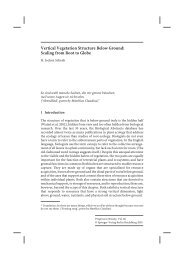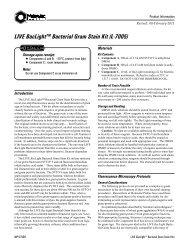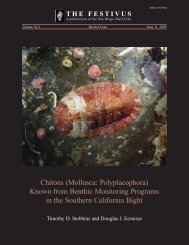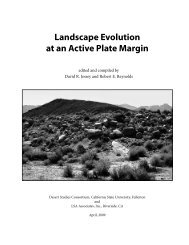2010 Overboard in the Mojave - Biological Science - California State ...
2010 Overboard in the Mojave - Biological Science - California State ...
2010 Overboard in the Mojave - Biological Science - California State ...
You also want an ePaper? Increase the reach of your titles
YUMPU automatically turns print PDFs into web optimized ePapers that Google loves.
fragment recovered from with<strong>in</strong> 0.5 m above <strong>the</strong> base of<br />
Member D (Fig. 6). Anodonta shells from 0.7 m above<br />
<strong>the</strong> base of Member D have produced <strong>in</strong>f<strong>in</strong>ite 14 C ages of<br />
47+ ka (Y-1993) (Stuiver, 1969; Bassett and Jefferson,<br />
1971) and 35+ ka (R. Berger, 1982, personal commun.).<br />
A U/Th age of 74.0 ka on mammalian bone and a U/Th<br />
age of 60.3 ka on Anodonta shell are reported by Bud<strong>in</strong>ger<br />
(1992) 1.5 and 2.0 m above <strong>the</strong> base of Member D<br />
respectively (Table 1) (Fig. 6). Given its stratigraphic<br />
position, <strong>the</strong> former age appears to be too old. An Anodonta<br />
horizon, <strong>in</strong> <strong>the</strong> uppermost exposures of Member<br />
D south of Manix, has yielded a 14 C age of 19.1 ± 0.25 ka<br />
(QC-1467) (R. Pardi, 1983, personal commun.). Bivalve<br />
rema<strong>in</strong>s from stratigraphically correlative strata <strong>in</strong> eastern<br />
Afton bas<strong>in</strong> have produced 14 C dates that range <strong>in</strong> age<br />
from ca. 31 ka to 28 ka and from ca. 21 ka to 18 ka (Table<br />
1) (Bassett and Jefferson, 1971; Hastorf and T<strong>in</strong>sley,<br />
1981; Meek, 1990, 1999).<br />
Paleontology of <strong>the</strong> Manix Formation<br />
The aquatic <strong>in</strong>vertebrate, and aquatic and terrestrial<br />
vertebrate taxa that compose <strong>the</strong> fossil assemblage from<br />
Lake Manix (Table 2) have been recovered from <strong>the</strong><br />
fluvial sediments of both <strong>the</strong> lower and upper wedges of<br />
Member B, <strong>the</strong> littoral deposits at <strong>the</strong> base and middle<br />
of Member C, and <strong>the</strong> fluvial sediments of Member D of<br />
<strong>the</strong> Manix Formation. Invertebrate fossils are restricted to<br />
Members C and D, and not unexpectedly, <strong>the</strong> rema<strong>in</strong>s of<br />
fish and aquatic birds are restricted to Member C.<br />
The fossiliferous part of <strong>the</strong> section ranges <strong>in</strong> age from<br />
>350 ka to ca. 20 ka, and spans late Irv<strong>in</strong>gtonian through<br />
late Rancholabrean North American Land Mammal Ages<br />
(LMA). Most of <strong>the</strong> mammalian genera represented <strong>in</strong><br />
<strong>the</strong> assemblage range through this entire period, and are<br />
found <strong>in</strong> Members B through D. However, <strong>the</strong> scimitartooth<br />
cat Homo<strong>the</strong>rium and Antilocapridae occur only<br />
at <strong>the</strong> base of Member C, and Bison is restricted to <strong>the</strong><br />
youngest deposits, Member D. Most vertebrate rema<strong>in</strong>s<br />
have been recovered from <strong>the</strong> base of Member C.<br />
Jefferson (1968) named <strong>the</strong> mammalian fossil assemblage<br />
from <strong>the</strong> Manix Formation <strong>the</strong> “Camp Cady local<br />
fauna” after <strong>the</strong> historic Union Army post that was located<br />
on <strong>the</strong> <strong>Mojave</strong> River 3.7 km southwest of Manix sid<strong>in</strong>g<br />
(Fig. 2). Camp Cady was occupied dur<strong>in</strong>g and shortly after<br />
<strong>the</strong> United <strong>State</strong>s civil war (Chidester, 1965). In 1968,<br />
Lake Manix deposits were though to encompass only <strong>the</strong><br />
Wiscons<strong>in</strong>, and <strong>the</strong> entire assemblage was assigned to<br />
<strong>the</strong> Rancolabrean LMA (W<strong>in</strong>ters, 1954; Howard, 1955;<br />
Jefferson, 1968). If reta<strong>in</strong>ed, this name (see Walsh, 2000,<br />
p. 268–270) should apply to only those fossils recovered<br />
from <strong>the</strong> upper wedge of Member C and Member D.<br />
george t. jefferson<br />
Figure 10. Partial skeleton of Aechmophorus occidentalis,<br />
western grebe (Natural History Museum of Los Angeles<br />
County specimen LACM 123458). The synsacrum and<br />
articulated left and right femora (46.1 mm <strong>in</strong> length) are to<br />
<strong>the</strong> lower left. Body and neck vertebrae occur to <strong>the</strong> right.<br />
A nearly complete skeleton of this animal was recovered<br />
from <strong>the</strong> base of Member C, Manix Formation (Jefferson,<br />
1985b). Note <strong>the</strong> excellent preservation of delicate<br />
osteological structures that is typical of <strong>the</strong> avian rema<strong>in</strong>s<br />
from Member C.<br />
The Lake Manix assemblage is significantly biased<br />
taphonomically toward large-sized mammals, although,<br />
exclud<strong>in</strong>g lower vertebrates, water fowl compose ~20% of<br />
<strong>the</strong> assemblage. Amphibians, lizards, snakes, <strong>in</strong>sectivores,<br />
bats, small carnivores, and small ungulates are absent.<br />
However, <strong>the</strong>se animals occur locally <strong>in</strong> o<strong>the</strong>r late Pleistocene<br />
assemblages like that from Schuil<strong>in</strong>g Cave (Downs<br />
et al., 1959; Jefferson, 1983) ~10 km west of <strong>the</strong> sou<strong>the</strong>rn<br />
edge of Troy Lake playa bas<strong>in</strong>, or from <strong>the</strong> ancestral <strong>Mojave</strong><br />
River deposits at Daggett and Yermo (Reynolds and<br />
Reynolds, 1985) ~20 km southwest of Camp Cady.<br />
Avian rema<strong>in</strong>s from <strong>the</strong> lacustr<strong>in</strong>e sedments are often<br />
partially articulated (Howard, 1955; Jefferson, 1985b)<br />
(Fig. 10). Those from <strong>the</strong> littoral deposits are not. Most<br />
mammalian fossils occur as s<strong>in</strong>gle, isolated skeletal elements<br />
that often exhibit some abrasion due to fluvial<br />
transport and/or wave action. Few mammalian osteologic<br />
elements are articulated. Under fluvial or littoral<br />
high energy depositional conditions, estimates of relative<br />
taxonomic abundance with<strong>in</strong> <strong>the</strong> assemblage (Table 3<br />
and 4) are better represented as a percentage of <strong>the</strong> total<br />
number of identified specimens (NISP) for each taxon,<br />
ra<strong>the</strong>r than on a calculated m<strong>in</strong>imum number of <strong>in</strong>dividuals<br />
(Horton, 1984; Badgley, 1986).<br />
Large mammalian herbivores far outnumber carnivores<br />
<strong>in</strong> modern faunas (23:1, Mech, 1966; >250:1,<br />
Schaller, 1972). The herbivore/carnivore ratio for <strong>the</strong><br />
larger mammals (larger than Canis latrans) <strong>in</strong> <strong>the</strong> Lake<br />
Manix assemblage is relatively well balanced with 672<br />
46 <strong>2010</strong> Desert Symposium
















